ECO504 Principles of Economics: Market Structures and Revenue
VerifiedAdded on 2023/06/15
|23
|3932
|463
Homework Assignment
AI Summary
This assignment solution for Principles of Economics (ECO504) covers key concepts including the difference between change in supply and change in quantity supplied, the impact of geopolitical events on markets, and the effects of electric car adoption on related industries. It delves into unit sales subsidies and their relationship with price elasticity of demand, using examples like wheat and precious metals. The assignment further discusses perfect competition, the role of average total costs, and the decision-making process for qualified accountants regarding cost minimization. It also explores the price elasticity of demand for alcohol and tobacco in Australia, competitive behaviors in different market structures, and the relationship between total revenue and marginal revenue. The document provides detailed explanations, diagrams, and examples to illustrate these economic principles.
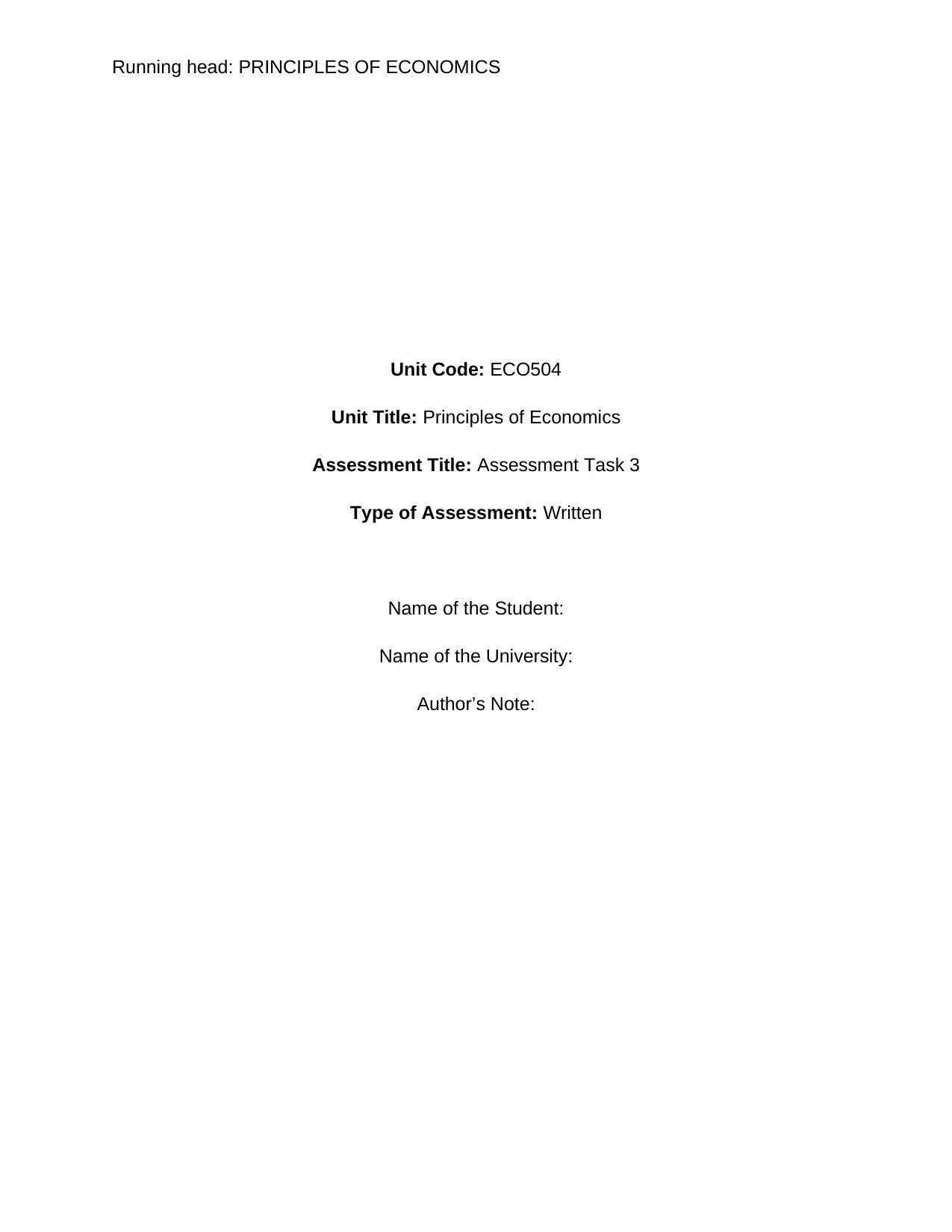
Running head: PRINCIPLES OF ECONOMICS
Unit Code: ECO504
Unit Title: Principles of Economics
Assessment Title: Assessment Task 3
Type of Assessment: Written
Name of the Student:
Name of the University:
Author’s Note:
Unit Code: ECO504
Unit Title: Principles of Economics
Assessment Title: Assessment Task 3
Type of Assessment: Written
Name of the Student:
Name of the University:
Author’s Note:
Paraphrase This Document
Need a fresh take? Get an instant paraphrase of this document with our AI Paraphraser
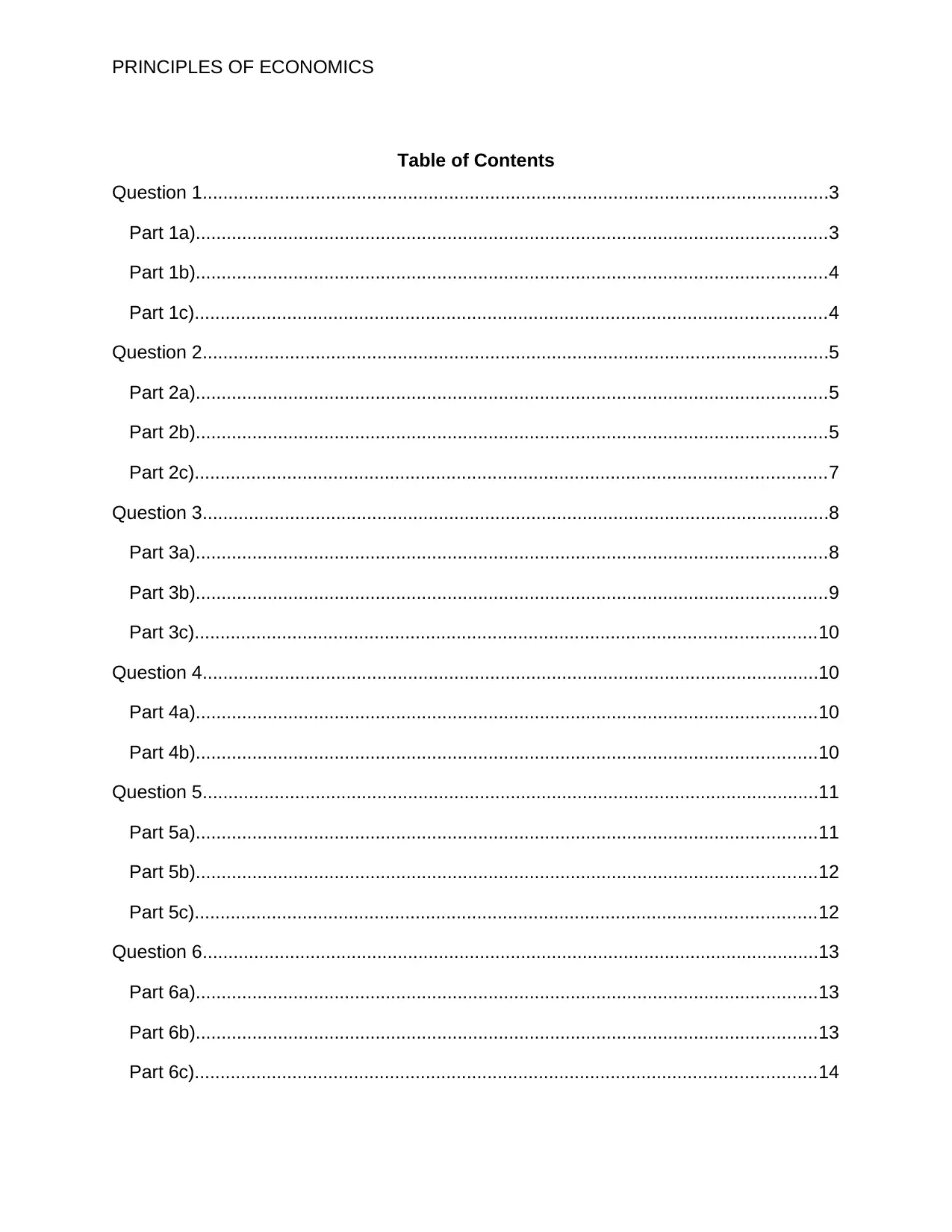
PRINCIPLES OF ECONOMICS
Table of Contents
Question 1..........................................................................................................................3
Part 1a)...........................................................................................................................3
Part 1b)...........................................................................................................................4
Part 1c)...........................................................................................................................4
Question 2..........................................................................................................................5
Part 2a)...........................................................................................................................5
Part 2b)...........................................................................................................................5
Part 2c)...........................................................................................................................7
Question 3..........................................................................................................................8
Part 3a)...........................................................................................................................8
Part 3b)...........................................................................................................................9
Part 3c).........................................................................................................................10
Question 4........................................................................................................................10
Part 4a).........................................................................................................................10
Part 4b).........................................................................................................................10
Question 5........................................................................................................................11
Part 5a).........................................................................................................................11
Part 5b).........................................................................................................................12
Part 5c).........................................................................................................................12
Question 6........................................................................................................................13
Part 6a).........................................................................................................................13
Part 6b).........................................................................................................................13
Part 6c).........................................................................................................................14
Table of Contents
Question 1..........................................................................................................................3
Part 1a)...........................................................................................................................3
Part 1b)...........................................................................................................................4
Part 1c)...........................................................................................................................4
Question 2..........................................................................................................................5
Part 2a)...........................................................................................................................5
Part 2b)...........................................................................................................................5
Part 2c)...........................................................................................................................7
Question 3..........................................................................................................................8
Part 3a)...........................................................................................................................8
Part 3b)...........................................................................................................................9
Part 3c).........................................................................................................................10
Question 4........................................................................................................................10
Part 4a).........................................................................................................................10
Part 4b).........................................................................................................................10
Question 5........................................................................................................................11
Part 5a).........................................................................................................................11
Part 5b).........................................................................................................................12
Part 5c).........................................................................................................................12
Question 6........................................................................................................................13
Part 6a).........................................................................................................................13
Part 6b).........................................................................................................................13
Part 6c).........................................................................................................................14
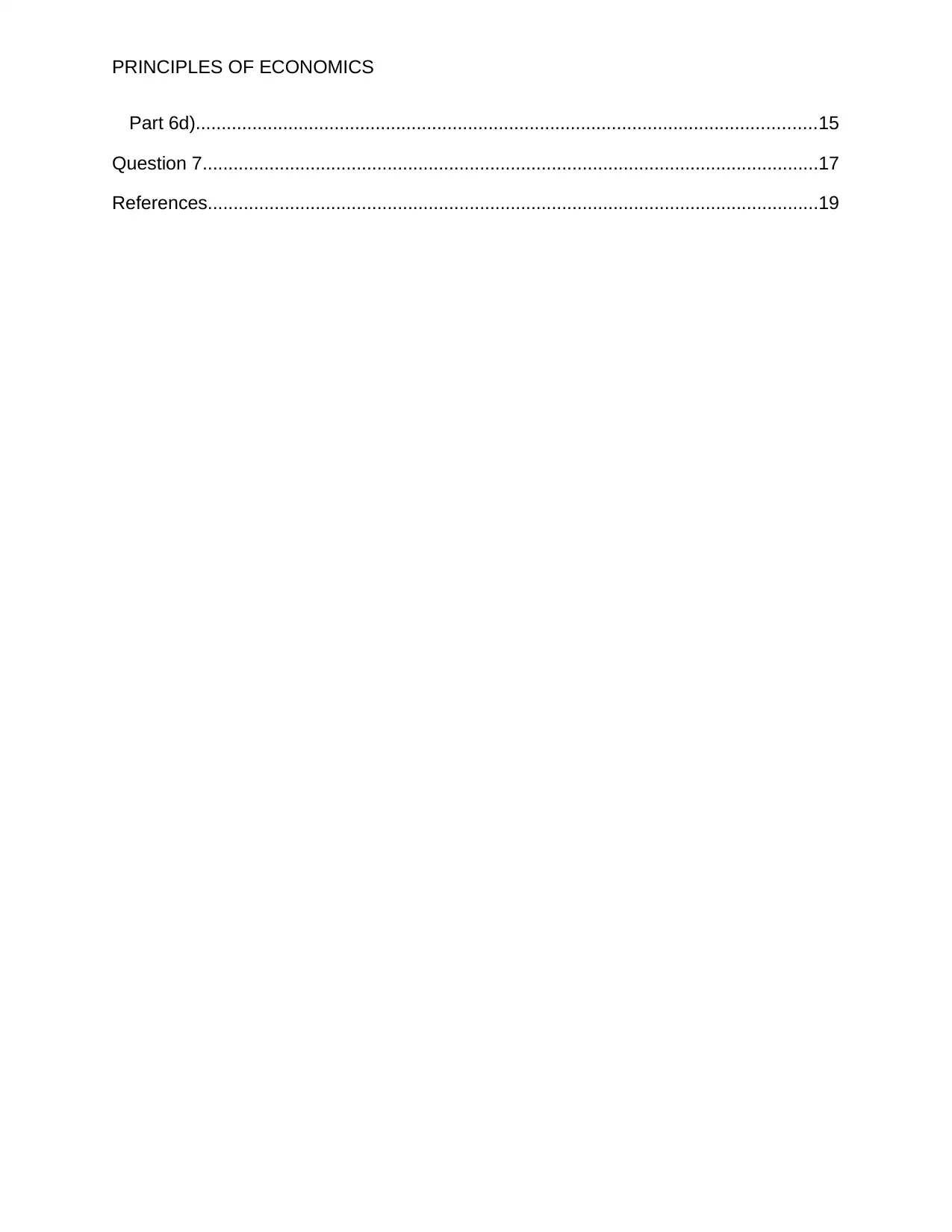
PRINCIPLES OF ECONOMICS
Part 6d).........................................................................................................................15
Question 7........................................................................................................................17
References.......................................................................................................................19
Part 6d).........................................................................................................................15
Question 7........................................................................................................................17
References.......................................................................................................................19
⊘ This is a preview!⊘
Do you want full access?
Subscribe today to unlock all pages.

Trusted by 1+ million students worldwide
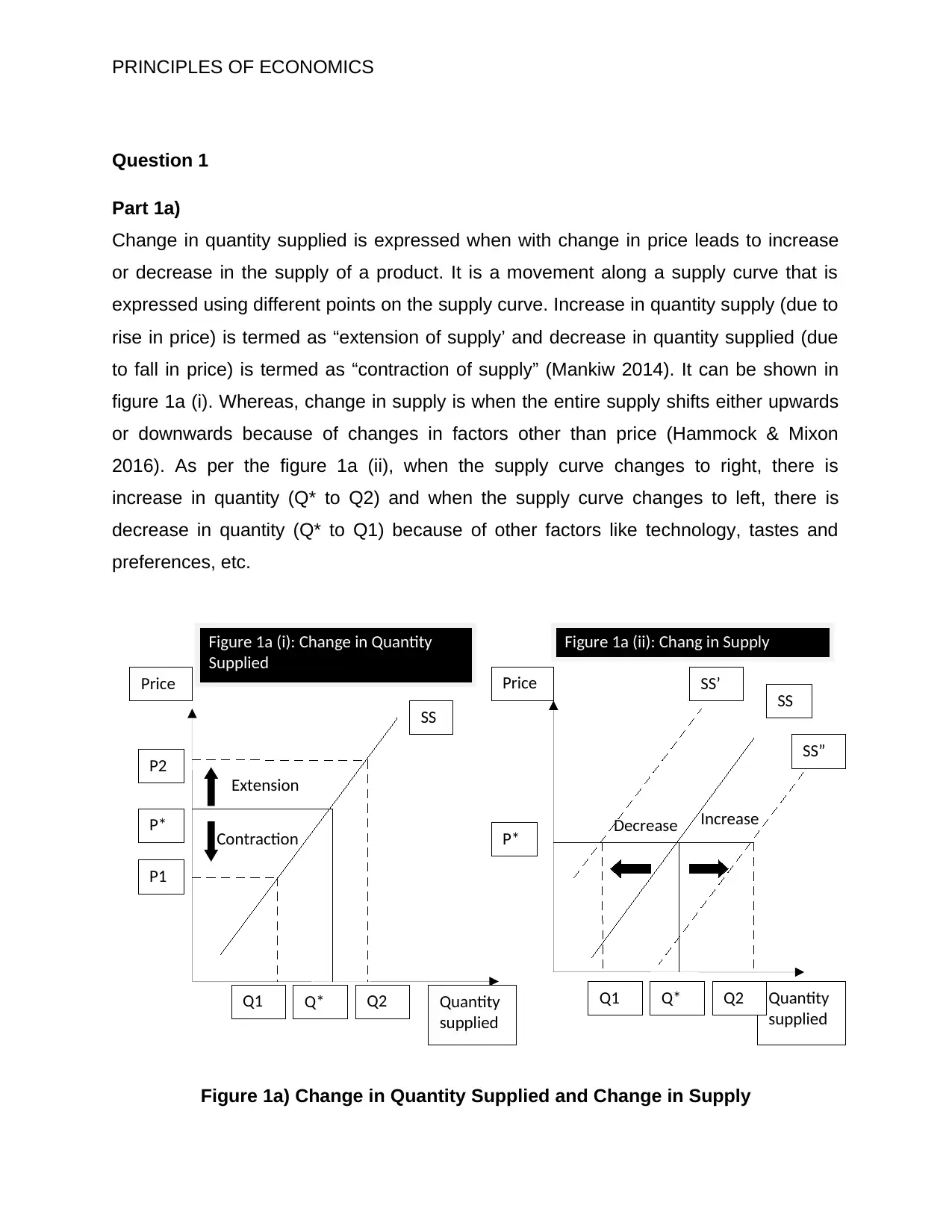
Extension
Q* Q2Q1
SS
SS”
SS’
P1
P2
P*
SS
Price
Quantity
supplied
Price
Quantity
supplied
Contraction
IncreaseDecrease
Figure 1a (i): Change in Quantity
Supplied
Figure 1a (ii): Chang in Supply
Q* Q2Q1
P*
PRINCIPLES OF ECONOMICS
Question 1
Part 1a)
Change in quantity supplied is expressed when with change in price leads to increase
or decrease in the supply of a product. It is a movement along a supply curve that is
expressed using different points on the supply curve. Increase in quantity supply (due to
rise in price) is termed as “extension of supply’ and decrease in quantity supplied (due
to fall in price) is termed as “contraction of supply” (Mankiw 2014). It can be shown in
figure 1a (i). Whereas, change in supply is when the entire supply shifts either upwards
or downwards because of changes in factors other than price (Hammock & Mixon
2016). As per the figure 1a (ii), when the supply curve changes to right, there is
increase in quantity (Q* to Q2) and when the supply curve changes to left, there is
decrease in quantity (Q* to Q1) because of other factors like technology, tastes and
preferences, etc.
Figure 1a) Change in Quantity Supplied and Change in Supply
Q* Q2Q1
SS
SS”
SS’
P1
P2
P*
SS
Price
Quantity
supplied
Price
Quantity
supplied
Contraction
IncreaseDecrease
Figure 1a (i): Change in Quantity
Supplied
Figure 1a (ii): Chang in Supply
Q* Q2Q1
P*
PRINCIPLES OF ECONOMICS
Question 1
Part 1a)
Change in quantity supplied is expressed when with change in price leads to increase
or decrease in the supply of a product. It is a movement along a supply curve that is
expressed using different points on the supply curve. Increase in quantity supply (due to
rise in price) is termed as “extension of supply’ and decrease in quantity supplied (due
to fall in price) is termed as “contraction of supply” (Mankiw 2014). It can be shown in
figure 1a (i). Whereas, change in supply is when the entire supply shifts either upwards
or downwards because of changes in factors other than price (Hammock & Mixon
2016). As per the figure 1a (ii), when the supply curve changes to right, there is
increase in quantity (Q* to Q2) and when the supply curve changes to left, there is
decrease in quantity (Q* to Q1) because of other factors like technology, tastes and
preferences, etc.
Figure 1a) Change in Quantity Supplied and Change in Supply
Paraphrase This Document
Need a fresh take? Get an instant paraphrase of this document with our AI Paraphraser
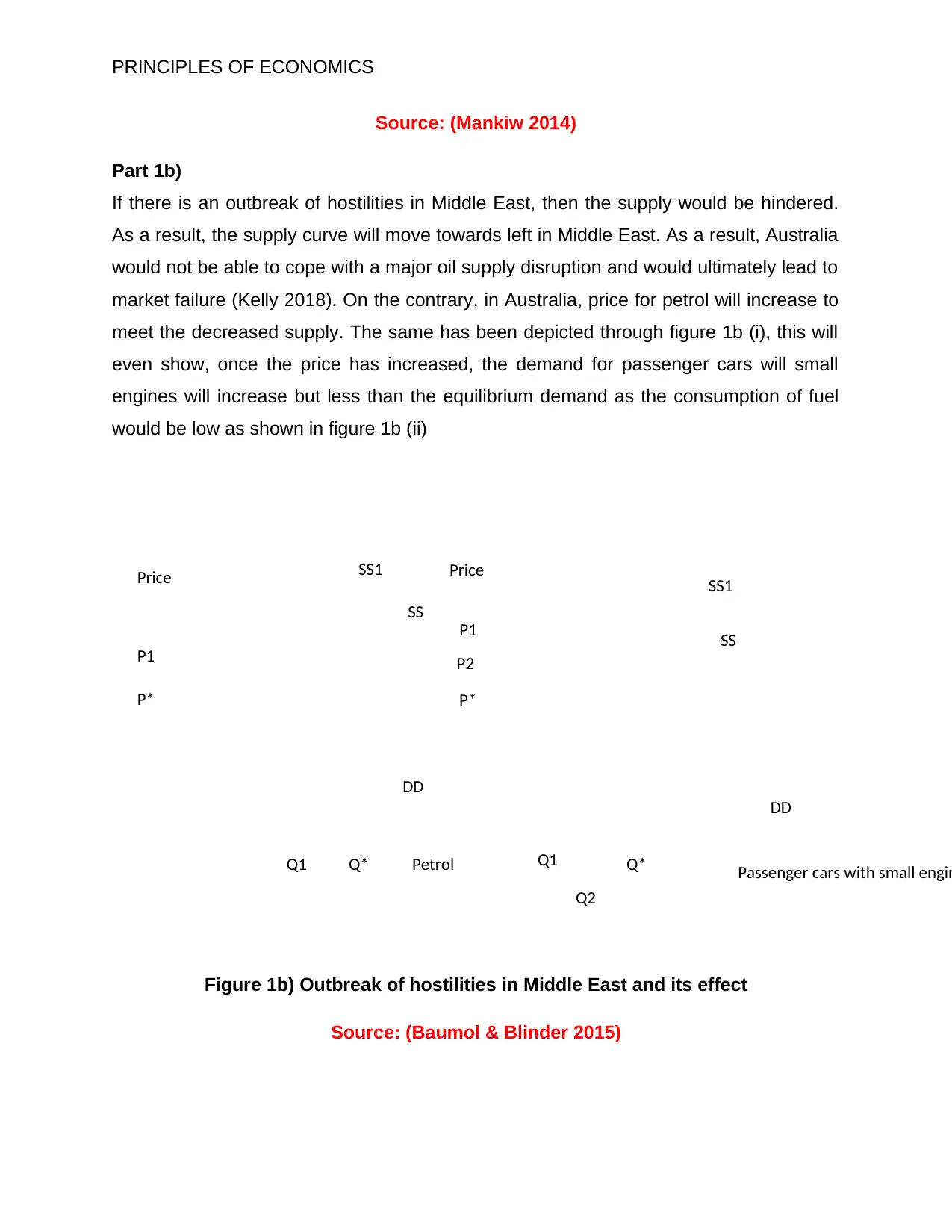
Q*Q1
P*
P1
Petrol
Price
DD
SS
SS1
Figure 1b (i): Effect on market for petrol
Q*Q1
P*
P1
Passenger cars with small engin
Price
DD
Figure 1b (ii): Effect on Passenger cars with small engines
SS1
SS
P2
Q2
PRINCIPLES OF ECONOMICS
Source: (Mankiw 2014)
Part 1b)
If there is an outbreak of hostilities in Middle East, then the supply would be hindered.
As a result, the supply curve will move towards left in Middle East. As a result, Australia
would not be able to cope with a major oil supply disruption and would ultimately lead to
market failure (Kelly 2018). On the contrary, in Australia, price for petrol will increase to
meet the decreased supply. The same has been depicted through figure 1b (i), this will
even show, once the price has increased, the demand for passenger cars will small
engines will increase but less than the equilibrium demand as the consumption of fuel
would be low as shown in figure 1b (ii)
Figure 1b) Outbreak of hostilities in Middle East and its effect
Source: (Baumol & Blinder 2015)
P*
P1
Petrol
Price
DD
SS
SS1
Figure 1b (i): Effect on market for petrol
Q*Q1
P*
P1
Passenger cars with small engin
Price
DD
Figure 1b (ii): Effect on Passenger cars with small engines
SS1
SS
P2
Q2
PRINCIPLES OF ECONOMICS
Source: (Mankiw 2014)
Part 1b)
If there is an outbreak of hostilities in Middle East, then the supply would be hindered.
As a result, the supply curve will move towards left in Middle East. As a result, Australia
would not be able to cope with a major oil supply disruption and would ultimately lead to
market failure (Kelly 2018). On the contrary, in Australia, price for petrol will increase to
meet the decreased supply. The same has been depicted through figure 1b (i), this will
even show, once the price has increased, the demand for passenger cars will small
engines will increase but less than the equilibrium demand as the consumption of fuel
would be low as shown in figure 1b (ii)
Figure 1b) Outbreak of hostilities in Middle East and its effect
Source: (Baumol & Blinder 2015)
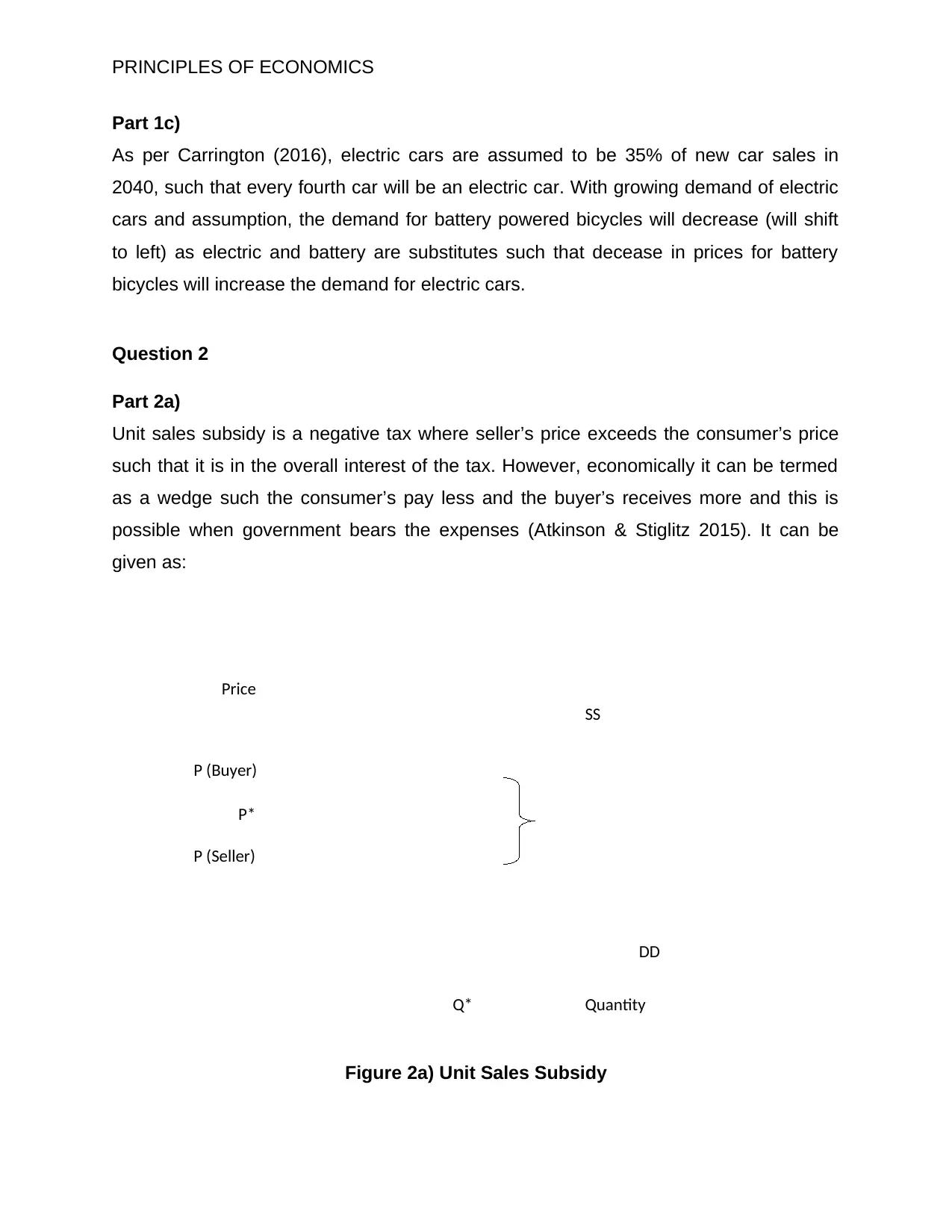
DD
SS
P*
Q*
P (Seller)
P (Buyer)
Price
Quantity
SUBSIDY
Figure 2a: Unit Sales Subsidy
PRINCIPLES OF ECONOMICS
Part 1c)
As per Carrington (2016), electric cars are assumed to be 35% of new car sales in
2040, such that every fourth car will be an electric car. With growing demand of electric
cars and assumption, the demand for battery powered bicycles will decrease (will shift
to left) as electric and battery are substitutes such that decease in prices for battery
bicycles will increase the demand for electric cars.
Question 2
Part 2a)
Unit sales subsidy is a negative tax where seller’s price exceeds the consumer’s price
such that it is in the overall interest of the tax. However, economically it can be termed
as a wedge such the consumer’s pay less and the buyer’s receives more and this is
possible when government bears the expenses (Atkinson & Stiglitz 2015). It can be
given as:
Figure 2a) Unit Sales Subsidy
SS
P*
Q*
P (Seller)
P (Buyer)
Price
Quantity
SUBSIDY
Figure 2a: Unit Sales Subsidy
PRINCIPLES OF ECONOMICS
Part 1c)
As per Carrington (2016), electric cars are assumed to be 35% of new car sales in
2040, such that every fourth car will be an electric car. With growing demand of electric
cars and assumption, the demand for battery powered bicycles will decrease (will shift
to left) as electric and battery are substitutes such that decease in prices for battery
bicycles will increase the demand for electric cars.
Question 2
Part 2a)
Unit sales subsidy is a negative tax where seller’s price exceeds the consumer’s price
such that it is in the overall interest of the tax. However, economically it can be termed
as a wedge such the consumer’s pay less and the buyer’s receives more and this is
possible when government bears the expenses (Atkinson & Stiglitz 2015). It can be
given as:
Figure 2a) Unit Sales Subsidy
⊘ This is a preview!⊘
Do you want full access?
Subscribe today to unlock all pages.

Trusted by 1+ million students worldwide

DD
SS
P1
Q*
P2
Demand
Price
Subsidy
P* Price fall
Consumption does not increase drastically
Wheat
PRINCIPLES OF ECONOMICS
Source: (Atkinson & Stiglitz 2015)
Part 2b)
The subsidies affect the consumer based on the price elasticity of demand depending
how much they have to pay when the demand is elastic or inelastic (Atkinson & Stiglitz
2015). Wheat’s demand is inelastic in nature depicting that no matter how much the
price fall; the consumption of wheat will not have a drastic change in demand (Kaushal
& Muchomb 2015, pp.25-42). This is shown in figure 2b) (i). In comparison, if we
compare to a luxury product like diamond and gold (precious metals); the consumption
will drastically increases even if the prices have not fallen to that level depicted in figure
2b (ii).
Figure 2b) (i) Inelastic Demand: Wheat
Source: (Atkinson & Stiglitz 2015)
SS
P1
Q*
P2
Demand
Price
Subsidy
P* Price fall
Consumption does not increase drastically
Wheat
PRINCIPLES OF ECONOMICS
Source: (Atkinson & Stiglitz 2015)
Part 2b)
The subsidies affect the consumer based on the price elasticity of demand depending
how much they have to pay when the demand is elastic or inelastic (Atkinson & Stiglitz
2015). Wheat’s demand is inelastic in nature depicting that no matter how much the
price fall; the consumption of wheat will not have a drastic change in demand (Kaushal
& Muchomb 2015, pp.25-42). This is shown in figure 2b) (i). In comparison, if we
compare to a luxury product like diamond and gold (precious metals); the consumption
will drastically increases even if the prices have not fallen to that level depicted in figure
2b (ii).
Figure 2b) (i) Inelastic Demand: Wheat
Source: (Atkinson & Stiglitz 2015)
Paraphrase This Document
Need a fresh take? Get an instant paraphrase of this document with our AI Paraphraser

DD
SS
P1
Q*
P2
Demand
Price
Subsidy
P*Prices does not fall a lot
Consumption increases drastically
Precious metals
PRINCIPLES OF ECONOMICS
Figure 2b) (ii) Elastic Demand: Precious Metals (Diamond, Gold)
Source: (Atkinson & Stiglitz 2015)
Part 2c)
Milk or all brands of milk are inelastic where there are no substitutes. Also, a product
like milk is insensitive to change in price, as a result, consumer will continue to but it
even if the price goes higher/ lower. The results would be that price elasticity of demand
will be greater than price elasticity of subsidy where incidence on producers will be
more than the consumers. The same has been depicted in figure 2c.
SS
P1
Q*
P2
Demand
Price
Subsidy
P*Prices does not fall a lot
Consumption increases drastically
Precious metals
PRINCIPLES OF ECONOMICS
Figure 2b) (ii) Elastic Demand: Precious Metals (Diamond, Gold)
Source: (Atkinson & Stiglitz 2015)
Part 2c)
Milk or all brands of milk are inelastic where there are no substitutes. Also, a product
like milk is insensitive to change in price, as a result, consumer will continue to but it
even if the price goes higher/ lower. The results would be that price elasticity of demand
will be greater than price elasticity of subsidy where incidence on producers will be
more than the consumers. The same has been depicted in figure 2c.

DD – Steep demand curve
SS
$3.9
Q*
$3.2
$6.4
Price of milk/ gal
Subsidy
$5.3 Price fall
All Brands of Milk
Incidence of subsidy on Producers
Incidence of subsidy on Consumers
PRINCIPLES OF ECONOMICS
Figure 2c) Inelastic Demand: All Brands of Milk
Source: (Mankiw 2014)
Question 3
Part 3a)
Perfect competition is not based on the theoretical base of abnormal profits. The
abnormal profits are not allowed based on the assumptions on the functioning of
perfectly competitive markets. The abnormal profits in industrial organization theory
were given by Bain highlighting the structural characteristic which makes it distinct
(Muiño & Núñez‐Nicke 2016, pp.298-328). Also, as devised specific firm-internal
characteristics are the considered to be main determinants for achieving abnormal
profits in perfectly competitive markets’. Moreover, if a firm is endowed with rare and
specific resources like in “resource based view” can result to be more competitive and
to generate profits further. Other determinants “knowledge based view or market based
view” can be considered other factors. However, these profits are solely on the
SS
$3.9
Q*
$3.2
$6.4
Price of milk/ gal
Subsidy
$5.3 Price fall
All Brands of Milk
Incidence of subsidy on Producers
Incidence of subsidy on Consumers
PRINCIPLES OF ECONOMICS
Figure 2c) Inelastic Demand: All Brands of Milk
Source: (Mankiw 2014)
Question 3
Part 3a)
Perfect competition is not based on the theoretical base of abnormal profits. The
abnormal profits are not allowed based on the assumptions on the functioning of
perfectly competitive markets. The abnormal profits in industrial organization theory
were given by Bain highlighting the structural characteristic which makes it distinct
(Muiño & Núñez‐Nicke 2016, pp.298-328). Also, as devised specific firm-internal
characteristics are the considered to be main determinants for achieving abnormal
profits in perfectly competitive markets’. Moreover, if a firm is endowed with rare and
specific resources like in “resource based view” can result to be more competitive and
to generate profits further. Other determinants “knowledge based view or market based
view” can be considered other factors. However, these profits are solely on the
⊘ This is a preview!⊘
Do you want full access?
Subscribe today to unlock all pages.

Trusted by 1+ million students worldwide
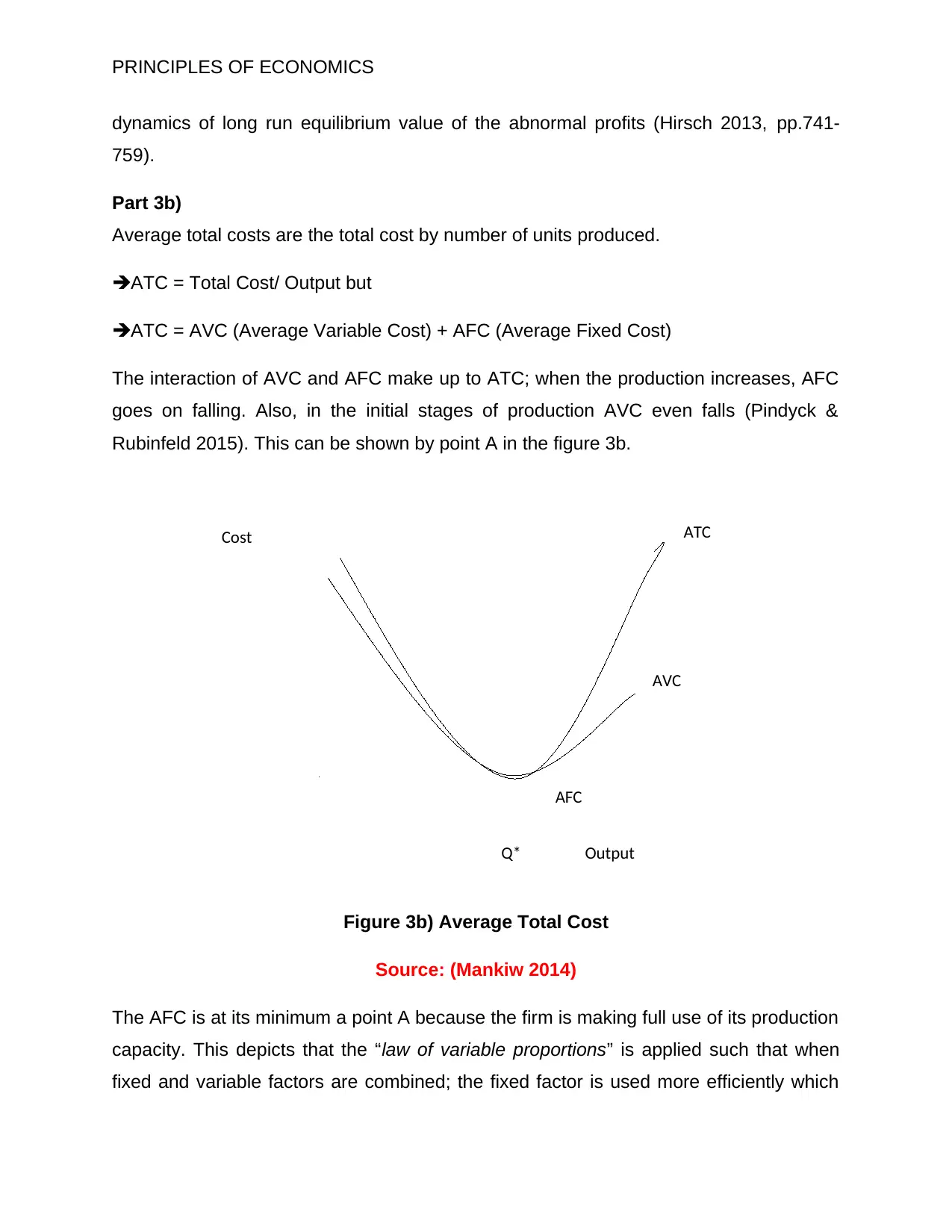
ATC
AFC
Q*
AVC
Cost
Output
“A”
PRINCIPLES OF ECONOMICS
dynamics of long run equilibrium value of the abnormal profits (Hirsch 2013, pp.741-
759).
Part 3b)
Average total costs are the total cost by number of units produced.
ATC = Total Cost/ Output but
ATC = AVC (Average Variable Cost) + AFC (Average Fixed Cost)
The interaction of AVC and AFC make up to ATC; when the production increases, AFC
goes on falling. Also, in the initial stages of production AVC even falls (Pindyck &
Rubinfeld 2015). This can be shown by point A in the figure 3b.
Figure 3b) Average Total Cost
Source: (Mankiw 2014)
The AFC is at its minimum a point A because the firm is making full use of its production
capacity. This depicts that the “law of variable proportions” is applied such that when
fixed and variable factors are combined; the fixed factor is used more efficiently which
AFC
Q*
AVC
Cost
Output
“A”
PRINCIPLES OF ECONOMICS
dynamics of long run equilibrium value of the abnormal profits (Hirsch 2013, pp.741-
759).
Part 3b)
Average total costs are the total cost by number of units produced.
ATC = Total Cost/ Output but
ATC = AVC (Average Variable Cost) + AFC (Average Fixed Cost)
The interaction of AVC and AFC make up to ATC; when the production increases, AFC
goes on falling. Also, in the initial stages of production AVC even falls (Pindyck &
Rubinfeld 2015). This can be shown by point A in the figure 3b.
Figure 3b) Average Total Cost
Source: (Mankiw 2014)
The AFC is at its minimum a point A because the firm is making full use of its production
capacity. This depicts that the “law of variable proportions” is applied such that when
fixed and variable factors are combined; the fixed factor is used more efficiently which
Paraphrase This Document
Need a fresh take? Get an instant paraphrase of this document with our AI Paraphraser
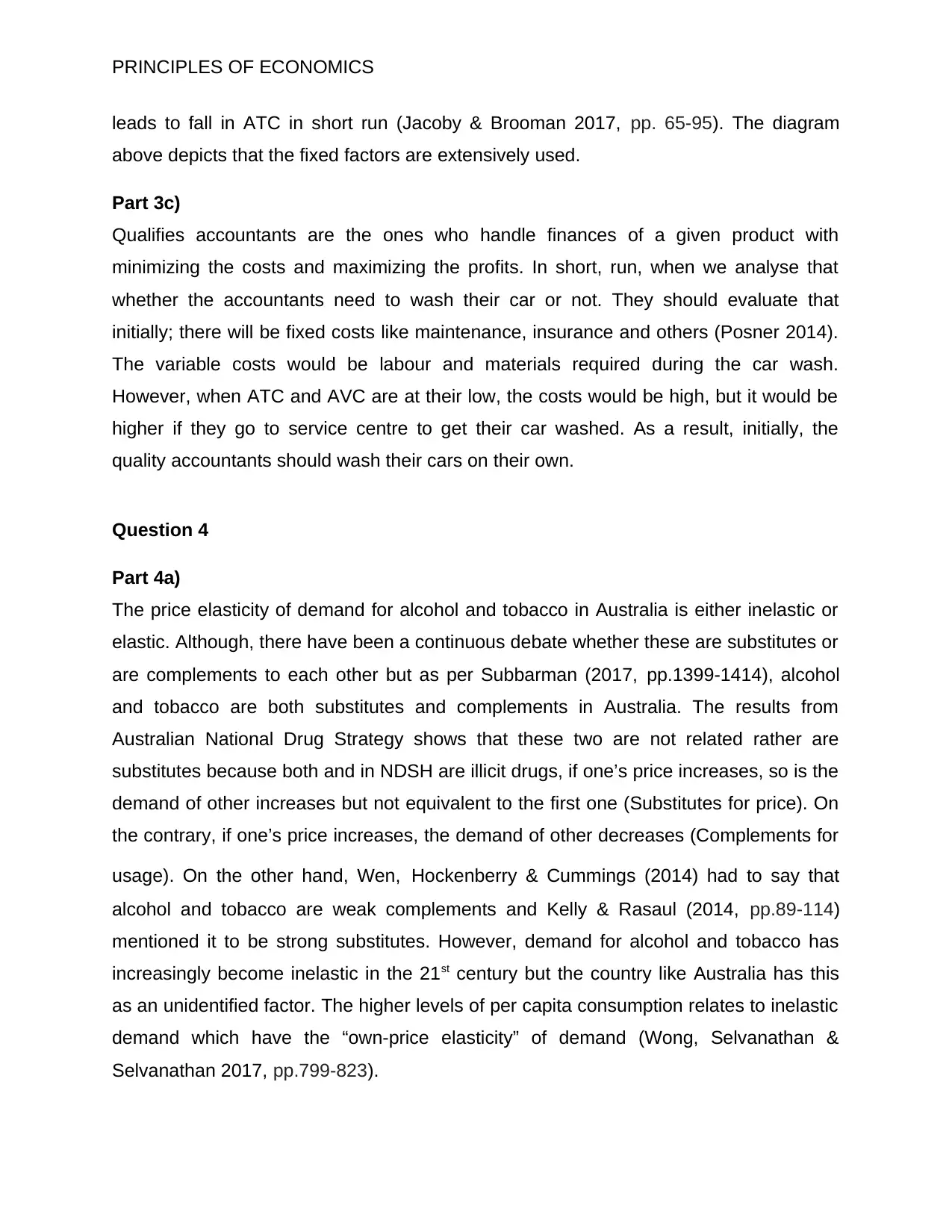
PRINCIPLES OF ECONOMICS
leads to fall in ATC in short run (Jacoby & Brooman 2017, pp. 65-95). The diagram
above depicts that the fixed factors are extensively used.
Part 3c)
Qualifies accountants are the ones who handle finances of a given product with
minimizing the costs and maximizing the profits. In short, run, when we analyse that
whether the accountants need to wash their car or not. They should evaluate that
initially; there will be fixed costs like maintenance, insurance and others (Posner 2014).
The variable costs would be labour and materials required during the car wash.
However, when ATC and AVC are at their low, the costs would be high, but it would be
higher if they go to service centre to get their car washed. As a result, initially, the
quality accountants should wash their cars on their own.
Question 4
Part 4a)
The price elasticity of demand for alcohol and tobacco in Australia is either inelastic or
elastic. Although, there have been a continuous debate whether these are substitutes or
are complements to each other but as per Subbarman (2017, pp.1399-1414), alcohol
and tobacco are both substitutes and complements in Australia. The results from
Australian National Drug Strategy shows that these two are not related rather are
substitutes because both and in NDSH are illicit drugs, if one’s price increases, so is the
demand of other increases but not equivalent to the first one (Substitutes for price). On
the contrary, if one’s price increases, the demand of other decreases (Complements for
usage). On the other hand, Wen, Hockenberry & Cummings (2014) had to say that
alcohol and tobacco are weak complements and Kelly & Rasaul (2014, pp.89-114)
mentioned it to be strong substitutes. However, demand for alcohol and tobacco has
increasingly become inelastic in the 21st century but the country like Australia has this
as an unidentified factor. The higher levels of per capita consumption relates to inelastic
demand which have the “own-price elasticity” of demand (Wong, Selvanathan &
Selvanathan 2017, pp.799-823).
leads to fall in ATC in short run (Jacoby & Brooman 2017, pp. 65-95). The diagram
above depicts that the fixed factors are extensively used.
Part 3c)
Qualifies accountants are the ones who handle finances of a given product with
minimizing the costs and maximizing the profits. In short, run, when we analyse that
whether the accountants need to wash their car or not. They should evaluate that
initially; there will be fixed costs like maintenance, insurance and others (Posner 2014).
The variable costs would be labour and materials required during the car wash.
However, when ATC and AVC are at their low, the costs would be high, but it would be
higher if they go to service centre to get their car washed. As a result, initially, the
quality accountants should wash their cars on their own.
Question 4
Part 4a)
The price elasticity of demand for alcohol and tobacco in Australia is either inelastic or
elastic. Although, there have been a continuous debate whether these are substitutes or
are complements to each other but as per Subbarman (2017, pp.1399-1414), alcohol
and tobacco are both substitutes and complements in Australia. The results from
Australian National Drug Strategy shows that these two are not related rather are
substitutes because both and in NDSH are illicit drugs, if one’s price increases, so is the
demand of other increases but not equivalent to the first one (Substitutes for price). On
the contrary, if one’s price increases, the demand of other decreases (Complements for
usage). On the other hand, Wen, Hockenberry & Cummings (2014) had to say that
alcohol and tobacco are weak complements and Kelly & Rasaul (2014, pp.89-114)
mentioned it to be strong substitutes. However, demand for alcohol and tobacco has
increasingly become inelastic in the 21st century but the country like Australia has this
as an unidentified factor. The higher levels of per capita consumption relates to inelastic
demand which have the “own-price elasticity” of demand (Wong, Selvanathan &
Selvanathan 2017, pp.799-823).

PRINCIPLES OF ECONOMICS
Part 4b)
Level of competition differs with each market. When analyzed from the perspective of
real markets then agriculture market faces a perfectly horizontal demand curves for
homogeneous proud in the industry with free entry and exit of firms. This market can be
termed as perfectly competitive market (Baumol & Blinder 2015). Nevertheless, other
markets are even highly competitive but they face high inelastic demand curves and
relatively not that easy to enter and exit the market. Moreover, in case of monopoly or
oligopoly, it implicitly or explicitly gets together in the setting prices and this does not
rule out competitive behavior (Pindyck & Rubinfeld 2015). To depict each market’s
competitive nature, figure 4b) is shown below from perfect competition to pure
monopoly.
Figure 4b) Competitive behaviours in each market
Source: (Pindyck & Rubinfeld 2015)
Question 5
Part 5a)
Total Revenue is the sum of all sales and marginal revenue is the addition to the total
revenue by making changes one unit per change in the output. Algebraically, MR and
TR can be given as:
TR = Price X Quantity; MR = Δ TR
Δ Q
MR for a ‘n’ units MRn = TRn – TRn-1
Part 4b)
Level of competition differs with each market. When analyzed from the perspective of
real markets then agriculture market faces a perfectly horizontal demand curves for
homogeneous proud in the industry with free entry and exit of firms. This market can be
termed as perfectly competitive market (Baumol & Blinder 2015). Nevertheless, other
markets are even highly competitive but they face high inelastic demand curves and
relatively not that easy to enter and exit the market. Moreover, in case of monopoly or
oligopoly, it implicitly or explicitly gets together in the setting prices and this does not
rule out competitive behavior (Pindyck & Rubinfeld 2015). To depict each market’s
competitive nature, figure 4b) is shown below from perfect competition to pure
monopoly.
Figure 4b) Competitive behaviours in each market
Source: (Pindyck & Rubinfeld 2015)
Question 5
Part 5a)
Total Revenue is the sum of all sales and marginal revenue is the addition to the total
revenue by making changes one unit per change in the output. Algebraically, MR and
TR can be given as:
TR = Price X Quantity; MR = Δ TR
Δ Q
MR for a ‘n’ units MRn = TRn – TRn-1
⊘ This is a preview!⊘
Do you want full access?
Subscribe today to unlock all pages.

Trusted by 1+ million students worldwide
1 out of 23
Related Documents
Your All-in-One AI-Powered Toolkit for Academic Success.
+13062052269
info@desklib.com
Available 24*7 on WhatsApp / Email
![[object Object]](/_next/static/media/star-bottom.7253800d.svg)
Unlock your academic potential
Copyright © 2020–2025 A2Z Services. All Rights Reserved. Developed and managed by ZUCOL.





